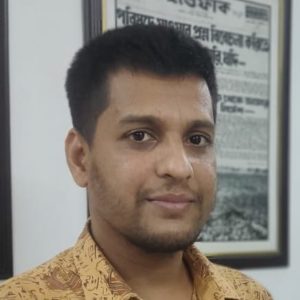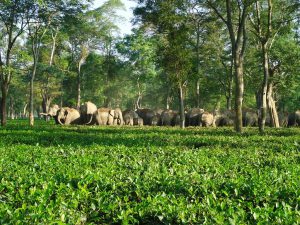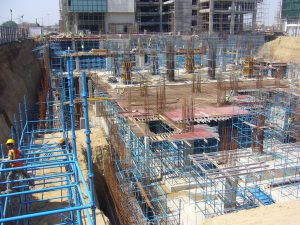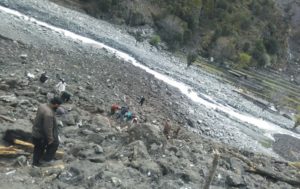Rini Roy is a 42 year old is a female farmer from the indigenous community of Sahapur, a remote village of Kaharol Upazila of Dinajpur district in northern Bangladesh. She has recently changed the destiny of her family by switching away from water-intensive cultivation of crops like paddy.
“We have only one acre of arable land. I sowed potato on the land and received a bumper harvest. We hope that my family would not face any trouble this year,” Rini said with smile on her face. The decisions on the farm are hers to take, as her husband, a small-time trader, has to spend his time in the town.
Apart from potato cultivation, Rini also cultivates vegetables at their homestead and on fallow land by the roadside. “I can earn BDT 2,000 (USD 25) per month selling vegetables. Now I am not dependant on my husband. I am a self-reliant,” she added.
Practicing climate-smart agriculture, her family is not facing any food insecurity nowadays and they are now financial solvent. Two of her sons are in university level, while another son just completed his high school studies.
Laxmirani, another female farmer of Sahapur, is a share-cropper. Despite having no own arable land of her own, she has managed to escape extreme poverty by cultivating crops on other’s land and ensuring food security for her three-member family.
“I lost my husband seven years ago. Since then, I have been struggling to survive. As a share-cropper I am sowing potato on two acres of land this year. Selling these potatoes, I will buy food grains,” she added.
Recalling her past when they lived in poverty, Laxmirani said agriculture has changed their lives and helps ensure food security. “And even I am now capable to bear the study expenses of my children. My two sons are now going to schools,” she said.
Shifting agriculture patterns
The northern region of Bangladesh is largely comprised of the comparatively elevated Pleistocene physiographic units of the Bengal Basin, called the Barind Tract, which is most drought-prone region in the country. Drought has become a recurrent natural phenomenon there in recent decades, leading to a decline in agricultural productivity. In response the women farmers have shifted away from growing rice.
“Once we cultivated rice, but now we are cultivating maize or potato and mustard seed since these varieties require small volume of water to cultivate,” Rini said.
ARM Asaduzzaman, the Agriculture Extension Officer of Kaharol Upazila, said farmers are changing their agriculture patterns because they are not receiving a fair price for paddy and because there is a lack of sufficient water sources to cultivate paddy during the dry season.
Strong market linkage
The price of agricultural outputs always plays a vital role to encourage farmers to cultivate those varieties of crops. Local agriculture office and NGOs helped female farmers set up a strong linkage with traders and receive a fair price for their agricultural produce.
A number of community-based farmers’ organisations have already been set up in Dinajpur. The leaders of these organisations negotiate the price of crops with local traders, said Moinul Haque Bappy, a project officer with the food security governance project of a local NGO, Pollisree.
After harvesting of crops, he said, traders move door-to-door of farmers to buy crops like potato and maize.
“We are now more aware of the price of agricultural products. We have already established a linkage with local traders, which help us get fair price,” Bichittra Roy, president of Sahapur Surjjomukhi Gono Songothon (a community-based women farmers organisation).
Although mobility of an individual is an important indicator of empowerment, mobility of women in Bangladesh is restricted. But in some cases, such as farming vegetables, women are now asserting themselves and finding an equal space with men as farmers in their own right.
Challenges remain
Most of the small and marginal framers rely on micro-credit system or informal sources to meet their agricultural expenses, because they frequently fail to manage loans from formal institutions. In fact, because formal systems draw away “better borrowers”, those borrowing from informal financial markets are compelled to pay higher interest rates.
Due to these reasons, Bappy said women share-croppers faced higher challenges than men when competing for farms. Since women sharecroppers could not invest as much as men – due to their dependence on informal forms of borrowing – the farm owners were less willing to give the land to women sharecroppers to farm. This makes the shift to high return, climate-resilient crops that much more significant.
![<p>Women farmers in Dinajpur [image by Rafiqul Islam]</p>](https://dialogue.earth/content/uploads/2016/04/DSC06881-e1459753439862.jpg)

![Hilsa fish at a market in Barisal, Bangladesh [image by Finn Thilsted]](https://dialogue.earth/content/uploads/2016/04/Hilsa-fish-bangladesh-pic-300x199.jpg)





